Joshua Tree National Park is one of my favorite California national parks, but unfortunately it is a little underappreciated (especially when viewed next to the California national park giants like Yosemite and Sequoia). But it’s time for this to change, because there are so many hidden gems and fun things to do in Joshua Tree…from hiking, to bouldering, to stargazing, and much more!
While you could easily spend days in the park, many people choose to visit Joshua Tree on a day trip from Los Angeles, Palm Springs, or the surrounding areas (I’ve even done it on a day trip from San Diego!). So if you only have a short time to experience this beautiful place…well, don’t fret. I’m here to help you figure out what you need to do to have an epic Joshua Tree day trip!
Contents
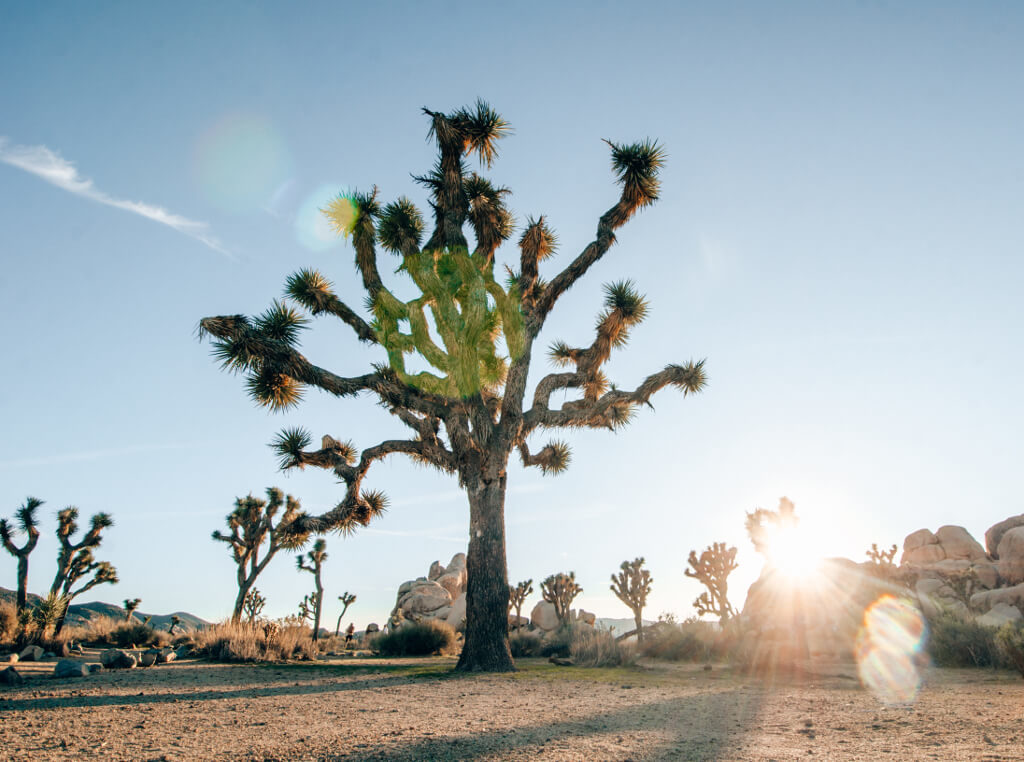
How To Spend One Day in Joshua Tree National Park
Ready to discover what to do to do on an epic Joshua Tree day trip? Here are all my favorite things that I would recommend doing if you want to see the best of Joshua Tree in a day!
1. See Joshua Trees in the North Part of the Park
If you’re heading to Joshua Tree National Park, there’s a pretty good chance you’re wondering where to see Joshua trees. Either that or you just assume they’re everywhere in the park so you can just drive in and see them!
Unfortunately, you can’t just drive in anywhere in the park and be treated to the sight of these plants. Joshua trees only grow in very specific environments and are only native to specific parts of the southwestern US including California, Arizona, Utah, and Nevada. Because these trees require an arid climate and only grow between 1,300 and 5,900 ft, they are almost exclusively found in the Mojave Desert which is where you’re headed on your Joshua Tree National Park day trip.
But Joshua Tree National Park actually is a meeting point for two deserts—the Mojave and the Colorado Desert (aka the Sonoran Desert). The lower elevation of the Colorado Desert means that Joshua Trees don’t grow in this part of the park, so if you want to see the park’s namesakes you will have to make sure you visit the northern section of the park.
And when you do visit the northern section…well, you’ll be treated to the spectacular sight of miles and miles of Joshua trees with their long arms stretching crookedly into the sky. It’s a bit like looking at an alien life form, as they are so strange and different from any other type of plant!
So my recommendation to see these trees is to head to the north or west entrances of the park and soon you will see a plethora of these unearthly trees on all sides of the road. Be sure to take some time to stop at a pulloff on the side of the road to appreciate the beauty of these strange plants!
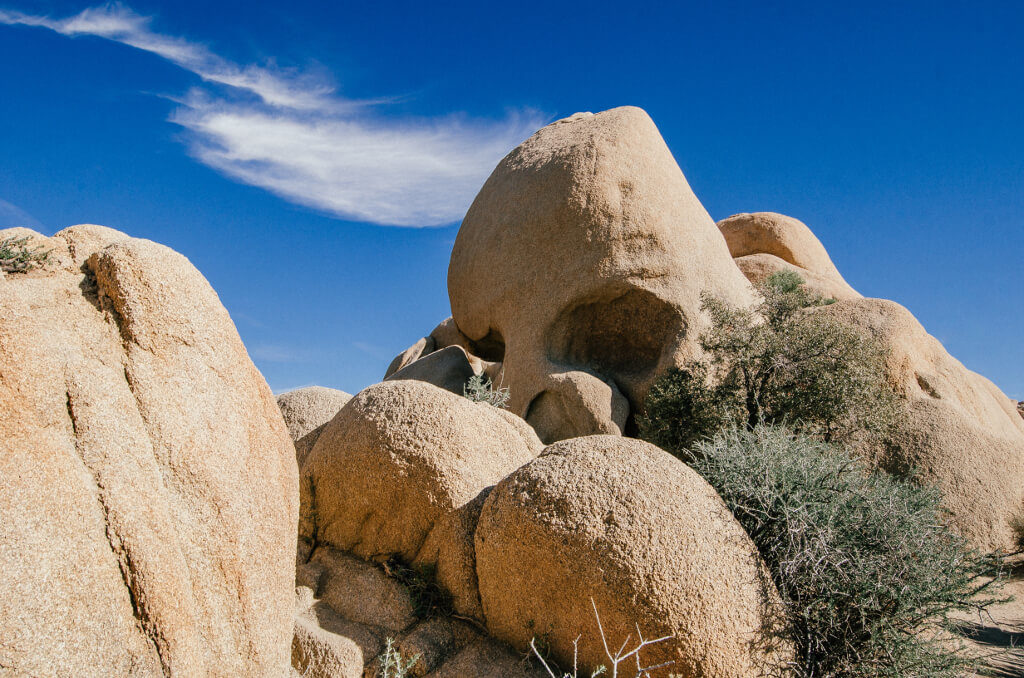
2. Get Up Close and Personal with Skull Rock
If your imaginations of the desert includes skulls strewn throughout the sand, then you’re in luck as Joshua Tree has its very own Skull Rock. This iconic rock looks eerily like a giant skull when seen from the right angle!
One of the nice things about Skull Rock is that there are plenty of places to hike nearby in the Jumbo Rocks area of the park, but the rock is actually just off the side of the road which means you can easily park and take a short stroll to see it before hopping back in your car. This is nice particularly if you’re trying to see Joshua Tree in one day, as you can experience this iconic sight for a short time before moving on to other sections of the park.
If you do choose to stay longer in the Jumbo Rocks area and take an actual hike, make sure to spend time admiring the large unearthly boulders and landscape. This is a perfect example of how Joshua Tree is not just a place with Joshua trees, but actually has varied desert landscapes throughout its 790,636 acres!
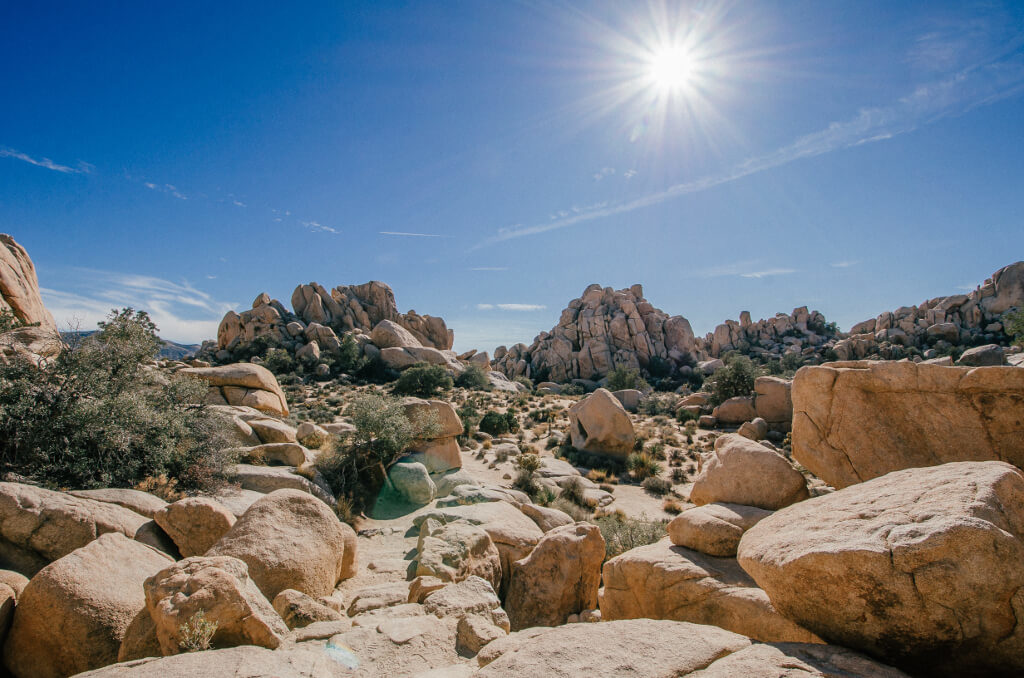
3. Explore Hidden Valley
Hidden Valley is another must-see stop when you visit Joshua Tree in one day. It’s an excellent place to take a short but beautiful hike with its 1-mile loop trail and varied species of plants and animals.
I also love this area because legend has it that it was a hideout for cattle rustlers many years ago…and when you enter the valley you can easily see why it would be the perfect place to hide stolen cows! There are so many crevices and sun-dappled rocks and you can really imagine what it must have been like back in these days of legend.
But if you love bouldering and climbing, that is probably one of the most compelling reasons to visit Hidden Valley during your one day at Joshua Tree. There are lots of famous rock formations in this area including one known as the “Great Burrito” and there are climbing areas nearby perfect for all levels. If you have your own equipment you can bring it along, or you could consider taking a rock climbing tour with gear included and an expert in case you need help.
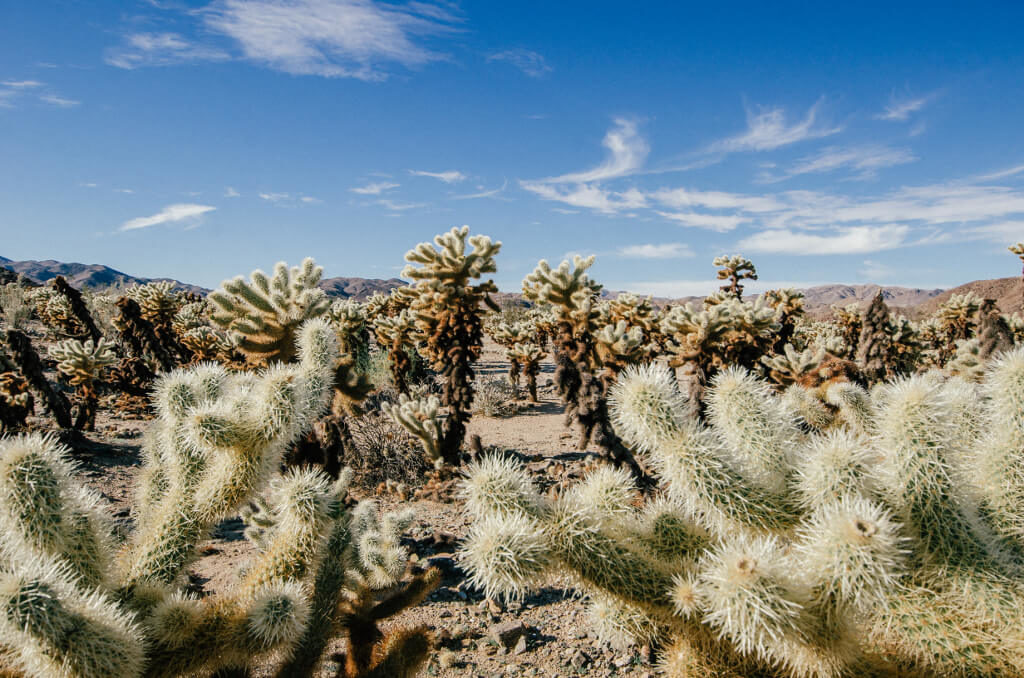
4. Wander the Cholla Cactus Gardens
Did I mention how varied the landscape of Joshua Tree is? Oh, that’s right, I did! 😉 But here’s more proof in action: as you move toward the southern section of the park, the Joshua trees start to fade away and you’ll come across the extraordinary Cholla Cactus Gardens.
The Cholla Gardens consist of 10 acres of teddy bear chollas in a loop trail. As you wander through the approximately 0.25 mile trail, these chollas surround you at every turn! You have to be very careful to stay on the path (and watch where you step!) for fear of treading on a piece of the barbed spines.
If you’ve been around chollas before, you hopefully already have a healthy fear of these prickly plants. If you haven’t been around them before, then let me just mention that you’re going to want to bring tweezers with you just in case anything goes wrong. But despite their reign of terror, these chollas in this large “garden” make up an unusual and compelling feature of the desert landscape. You certainly won’t want to miss it while visiting Joshua Tree National Park!
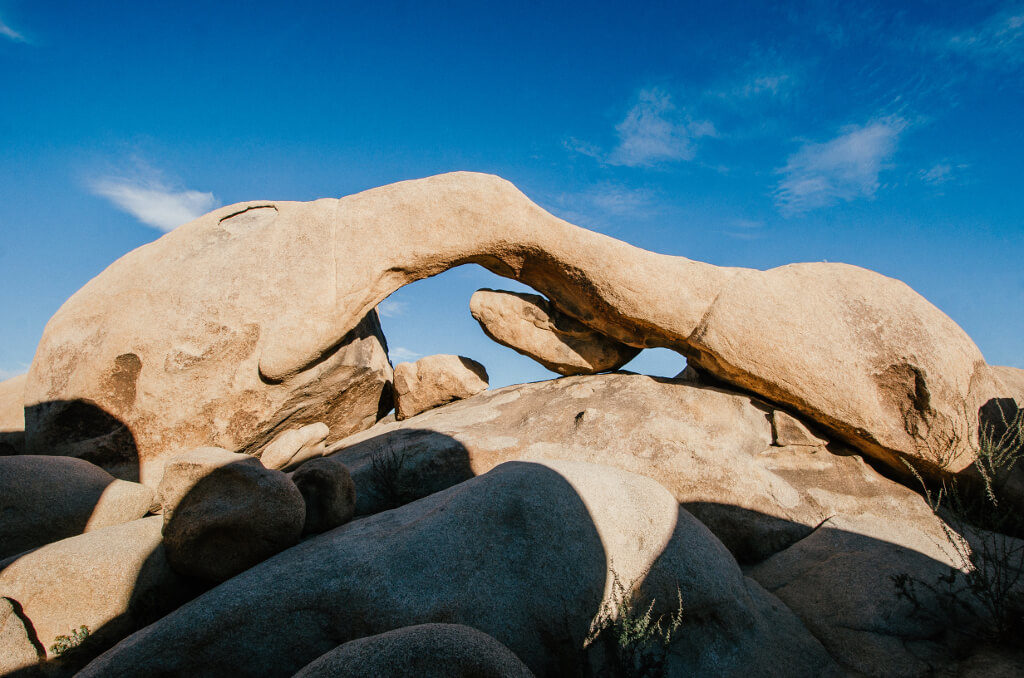
5. Hike to Arch Rock
If you’re looking for an Instagram hot spot on your Joshua Tree one day trip, then Arch Rock is the perfect place to go. In fact, even if you aren’t looking for the perfect picture for the ‘gram this is still a must see!
Just a short 0.5 mile hike from White Tank Campground, this gorgeous natural rock formation appears to defy gravity! It can be a bit of a scramble to get up to the boulder where Arch Rock sits, so you’ll want to be sure-footed and wear appropriate footwear. But the reward of seeing this natural wonder up close makes it so worth it!
And, of course, once you’re there you can even go right up to it to pose for pictures. It is a popular place, though, so at peak points of the day you may need to wait in line for your chance to climb closer.

6. Visit the Hall of Horrors
If there’s one place you need to visit (if only for the name) it’s the Hall of Horrors. It’s a surprisingly pleasant place despite its name!…and in fact, it’s one of my favorite areas in the park.
This area takes its name from the “halls” or alleyways formed by giant rocks sitting next to each other. You can actually take the Hall of Horrors trail and walk through these paths formed between boulders! It’s perhaps not the best place for people with claustrophobia, but if you can handle it then it is really cool to explore.
This is also one of my favorite spots for sunset at Joshua Tree, so if you’re looking for a good sunset spot then you should consider this one. The sun silhouettes the Joshua trees and boulders against the skyline as it starts to set, which makes for a really pretty picture and a really pretty sunset in real life! Do be aware, though, that if you want to come here for sunset you will want to get here a little earlier than the actual sunset time as the large boulders on the horizon start to block out the sun earlier than you’d expect. Getting here in time to see the sun go down and turn the sky brilliant shades of pink and orange is an unforgettable sight!
7. Stargaze in Joshua Tree National Park
Another thing that Joshua Tree is famous for (and that your one day trip to Joshua Tree won’t be complete without) is stargazing! Of course, it’s even better if you decide to stay the night in one of the park’s campgrounds…but even if you’re only spending one day in Joshua Tree you’ll want to stay around past sunset to see the stars come out.
I recommend bringing blankets to stay warm so you can sit on your car or another vantage point and stare up at the sky. You’ll be amazed by all the countless stars and the Milky Way in the sky! (Also, a pro tip for you: this is an excellent place to watch the Perseid meteor shower in August every year!)
Although this wraps up your Joshua Tree one day itinerary, all this just scratches the surface of the amazing things you can do in this park! It really is worth a visit whether you can come for one day or for longer, and I’m sure you’ll want to return here again very soon.
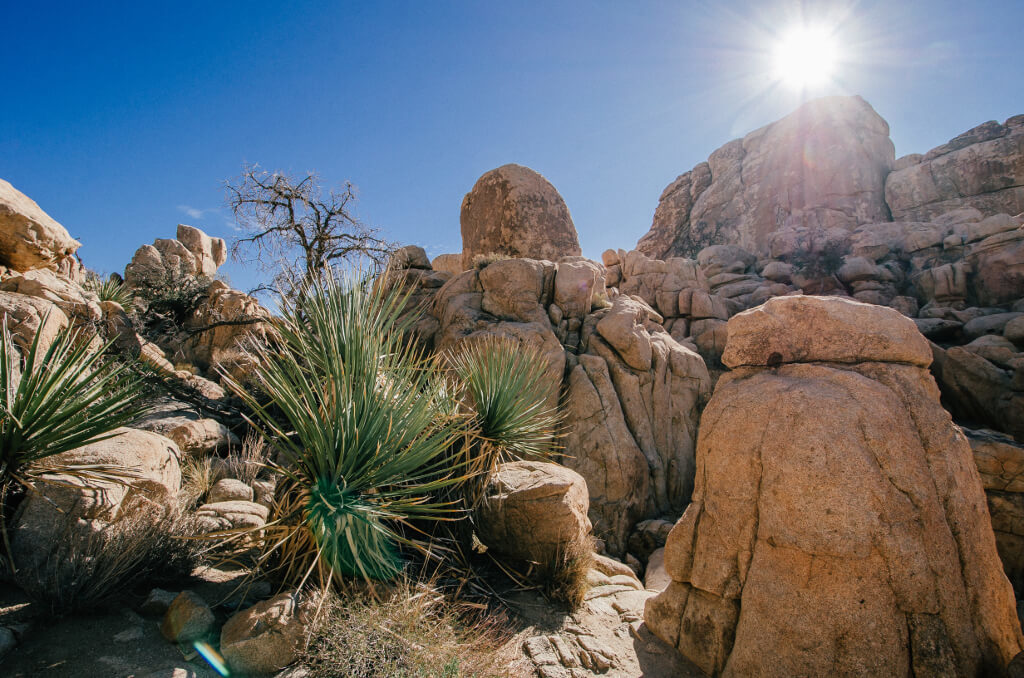
Best Time to Visit Joshua Tree
Now that you know where to go in Joshua Tree National Park in a day, let’s talk about when you should visit. Visiting Joshua Tree is captivating all year round, but if you’re looking for the best time to go there are a few options that may make your time more pleasant.
Personally, I love Joshua Tree in the spring because everything is blooming and in the fall because it’s usually not too hot. These would be my first choices of times to visit (as well as anytime there’s a cool astronomical event happening!)
Winter can be a bit cold/dreary at times just as in other areas of California, and summer can get HOT HOT HOT! Especially in areas where there’s very little shade while you’re hiking (which is a lot of places). Does that mean I wouldn’t go in summer? No, of course not! I’d go anytime of year. But if you’re looking for the ideal time to visit I’d definitely have to go with spring or fall.
How to Visit Joshua Tree
Wondering how to get to Joshua Tree for your day trip? Curious about the costs to visit? This section will help you learn some practical things you need to know before you go.
1. Drive to Joshua Tree
My favorite way to visit Joshua Tree is by taking my own car and exploring the park on my own. I love the flexibility and love being able to go at my own pace!
If you are from a nearby area or are on a road trip, this is a good option for you as well. But if you are visiting from out of state or out of the country, this may be more complicated or you may need to rent a vehicle for the day. (Side note: if you don’t want to rent or simply don’t want to drive yourself around the park, skip to the next option!)
If you’re going to Joshua Tree on your own, you can choose which of the three entrances you use: the West (Main) Entrance in the town of Joshua Tree, the North Entrance in 29 Palms, and the South Entrance near Indio/Palm Springs. Which entrance you choose will depend on where you are coming from and what part of the park you want to see first. Remember, the Joshua trees are primarily concentrated in the north section of the park…so the north or west entrances may be best if you have a short time to see the park and want to make sure you see some beautiful Joshua trees!
All three entrances will require you to either pay to enter or pay for/use a national parks pass. The pass is an excellent and cost-saving option, especially if you already know you will be returning here or visiting other national parks within a year! They also offer free or discounted passes for seniors, those with disabilities, 4th grade students, and a few other qualifying people as well.
2. Take a Tour
If you don’t have your own car, don’t want to drive, or simply would prefer to go with a group and with a guide, it is also possible to take a guided tour of Joshua Tree. There are lots of options that could be fun, but be sure to check what is on the tour’s itinerary. You will need to make sure the itinerary covers whatever is most important to you, because you rarely get to give input or change up the itinerary while you are in the park (unless, perhaps, it’s a private tour).
Here are a few options to consider:
- Joshua Tree National Park Jeep Tour: This 4-hour Jeep tour takes you along back-country trails to see magnificent vistas, Joshua Tree’s stunning rock formations, and much more! It leaves from Palm Desert (although some hotels are included in a complimentary pickup and drop-off) and choosing this tour means you will not have to pay National Park fees. Bottled water, snacks, and a guide are also included to help you have the best time in this rugged national park! Click here to check out this tour.
- Joshua Tree Hummer Adventure: The tour takes you on a 4-hour journey across the California desert—from the San Andreas Fault to Joshua Tree National Park! At San Andreas, you explore an oasis and walk over a bridge crossing San Andreas fault before continuing on to Joshua Tree National Park, where you will complete your adventure by climbing Eureka Peak to get amazing views of the valley. Included in this tour is transport by Hummer, entry into the oasis at San Andreas Fault, and entry into Joshua Tree National Park. Click here to see more details!
- Joshua Tree National Park SUV or Van Tour: This van tour takes you to several beautiful stops within Joshua Tree, from Keys View overlook, to Hidden Valley where you will enjoy a guided hike, to a short stop at the visitor center. This tour is the perfect opportunity to learn more about this amazing National Park and it’s dramatic history, as well as discover the variety of plant life that makes the desert so intriguing. If you join the tour on a day trip from Palm Springs, then you will also get to enjoy a narrated tour of the Coachella Valley on your way to Joshua Tree. Alternatively, you can join the tour at the visitor center. Included in this 3 hour tour option is a naturalist guide to share history and answer all your questions, a nature hike, snacks and water, Joshua Tree admission, and a picnic lunch. Click here to learn more about this tour and see if it’s the right option for you!
- USA National Parks Explorer: Want to visit Joshua Tree alongside several other of the best national parks in the US? This 18 day trip is perfect for those who want to experience the most amazing landscapes in the west of the US, including Joshua Tree, the Grand Canyon, Death Valley, and more. Even better—it’s fully planned out for you and you don’t have to drive! Check out more about this itinerary and the stunning sights you’ll see on this tour!
- LA to Vegas Adventure: Like the idea of a fully planned out itinerary but only have a week? This 6 day tour takes you to Joshua Tree and Grand Canyon along your way from LA, to San Diego, to Las Vegas. Want to learn more? Check out the tour’s information!
Planning a California road trip that includes Joshua Tree National Park? Check out this ultimate road trip guide to make sure you have everything you need!
Planning for Your Joshua Tree Day Trip
There are several things you’ll need to know and prepare for when planning a Joshua Tree trip…from navigation to what to bring to Joshua Tree. Here are the most important things to consider before you go!
Navigation and Driving
There are no gas stations inside the park so you will want to fill up before you enter. You don’t want to get stuck if you run out of gas!
Also, cell phone coverage is spotty (at best) and usually non-existent in the park. You’ll want to make sure you don’t need to receive or make any phone calls during your time in the park, and you’ll also want to make sure you have access to a map so you can find your way around once you’re inside and don’t have cell service.
There are a few ways to prepare so you can navigate the park while you’re inside without connection: go old school and download or buy a Joshua Tree map before you go, or stay technologically advanced and download Google Maps offline so you can use your phone to navigate even without connection. Here’s a quick video that demonstrates how to download maps offline:
Supplies for a Day in Joshua Tree
You will want to come prepared with supplies to last you through your day trip. Here are a few items to consider:
- Water: Remember that you’ll be going to the desert, and the desert is dry. You’ll want to bring lots of water to keep you hydrated!
- Reusable Bottle: Consider bringing a reusable bottle to refill throughout your time in Joshua Tree. Bringing a reusable bottle means you’ll be using less plastic but can still easily stay hydrated!
I like this bottle for cold drinks or this one if I need a versatile bottle that can work for both hot and cold liquids. - Food: There are no places to buy food in the park, so anything you need you will need to bring with you. You’ll want food for lunch as well as plenty of snacks for throughout the day. Some good snacks to bring include easy-to-eat foods like carrots and cucumbers, dried and fresh fruit, trail mix, and granola bars (these are my favorite!)
- Sunscreen: You’ll want to bring some good sunscreen to protect your skin while you explore. Joshua Tree is in the desert, after all, and the desert means lots of sun! This is a great lotion sunscreen to have on hand, and this is my favorite powdered sunscreen.
- Sunglasses: For the same reason as bringing sunscreen, you will also want to bring good sunglasses. If you need a good pair, check out this classic sunglasses look or this one.
- First Aid Kit: A compact first aid kit is essential on any Joshua Tree trip. This one is a great option and is easy to carry!
- Tweezers: If your first aid kit doesn’t include tweezers, you will definitely want to add them! Especially if you plan to visit the Cholla Cactus Garden. There are plenty of spiky things in the desert, and no one wants to have to walk around the park all day with a cactus spine embedded in their skin. These are some good tweezers for splinter and cactus spine removal.
- Flashlight: A flashlight is handy to have on hand if you will be hiking near sunset, and is also comforting to have on hand in case of emergency if you plan to stay after dark to stargaze. This flashlight is compact, super bright, and rechargeable so it is a great option for Joshua Tree.
- Day Pack: You’ll need a good day pack to carry all your water, snacks, and other items with you while hiking and exploring. Check out this pack from Osprey if you are looking for a good one to bring.
- GoPro: If you’re the adventurous type and haven’t yet bought a GoPro, what are you waiting for? This durable little camera is perfect for capturing adventures while climbing, bouldering, hiking and more. I’m a big fan of photos and capturing moments, so the GoPro is an essential part of my gear whenever I go exploring! Click here to check out prices and reviews of the GoPro HERO7.
What to Wear to Joshua Tree
If you aren’t from California, you might not expect this…but the California desert isn’t always hot. There are freezing days in the winter season, and even during the summer it can get very cold in the evenings! Here are some recommendations for what to wear:
- Hiking Clothes: You will want to make sure you bring clothes to hike in during the day. Depending on your preference and the time of year, this may mean wearing long pants or shorts and long sleeve shirts or short sleeve shirts. Choose clothes that are comfortable and will keep you at a good temperature!
- Dress in Layers: The weather in California changes across seasons, and even across times of the day! If you plan to spend the whole day in Joshua Tree, you may find that in the mornings and evenings you need to add extra layers to stay warm. This is a good coat option for chilly mornings and evenings in a national park. And of course, as you hike and start to get warm you may want to shed some layers too…so dressing in layers really is best!
- Sturdy Shoes: For hiking, you will definitely want to wear sturdy, closed toe shoes. Closed toe shoes are best because you don’t want to get cactus spines in your toes or feet as you walk! And if you plan to hike a lot, you will definitely want a good pair of shoes to keep you comfortable throughout the day. These are my favorite hiking boots that I take with me on all my national park adventures.
- Hats: There aren’t many trails or places with shade in Joshua Tree, so it is very important to bring a hat with you on sunny days!
Decided you want to stay longer in Joshua Tree and need a place to stay? Check out these great options!
- The Castle House Estate – Most unique
- Joteme – Good for groups
- High Desert Motel – Budget friendly
Save for Later

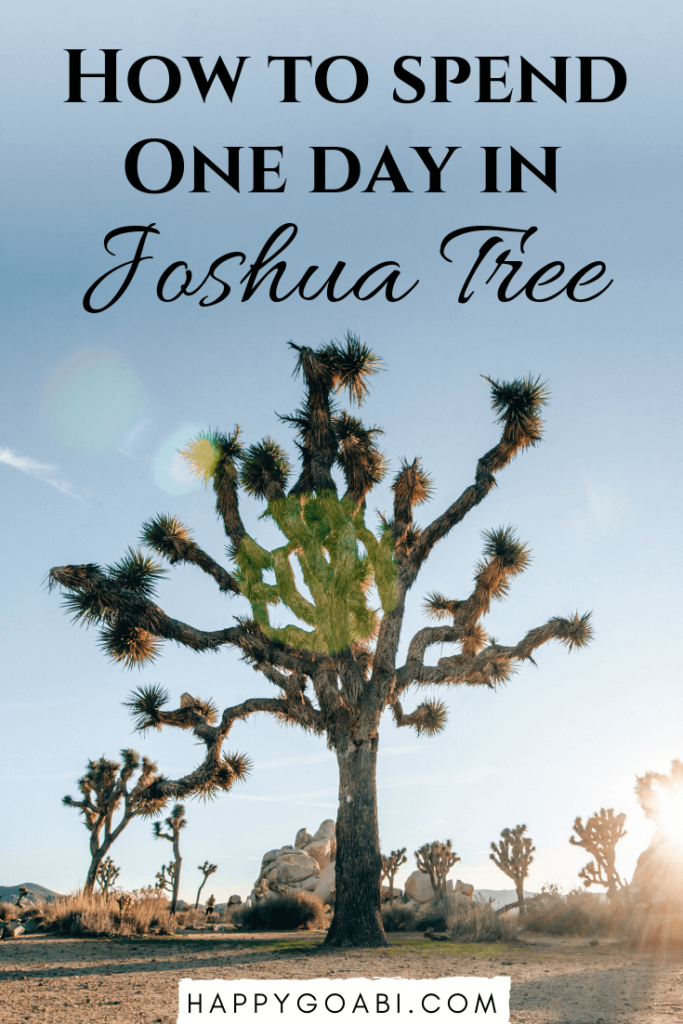


Thank you so much for this thorough article. It was very helpful.
Is it safe to drive from Joshua Tree to Palm Springs at night? If we stay for the stars.. Is there light on the roads on the way back?
Hi Melissa – that’s a great question! There are two routes that you might take to Palm Springs from Joshua Tree: the 62 and the 10. I’ve driven the 62 in the dark on my way to San Diego from Joshua Tree, and most of it is unlit. There are also no medians which can be a safety concern. Personally, I didn’t mind it much and I made it home safe…but I know that in general there are stretches of the 62 that are considered quite unsafe no matter the time of day, so you may prefer not to drive it in the dark.
I haven’t driven on that stretch of the 10 recently and have never personally driven on it in the dark, but from what I remember I don’t believe it would be well lit either. However, it does have a median in most places, which will make it a bit safer than the 62.
I think the question of whether it is safe or not simply comes down to your tolerance for driving at night and how comfortable you are driving on more rural roads. If you want to see the stars but don’t wish to drive back in the dark, you might consider camping in the park or staying in nearby Twentynine Palms so you don’t have to drive all that way at night. I hope this helps you make your decision!